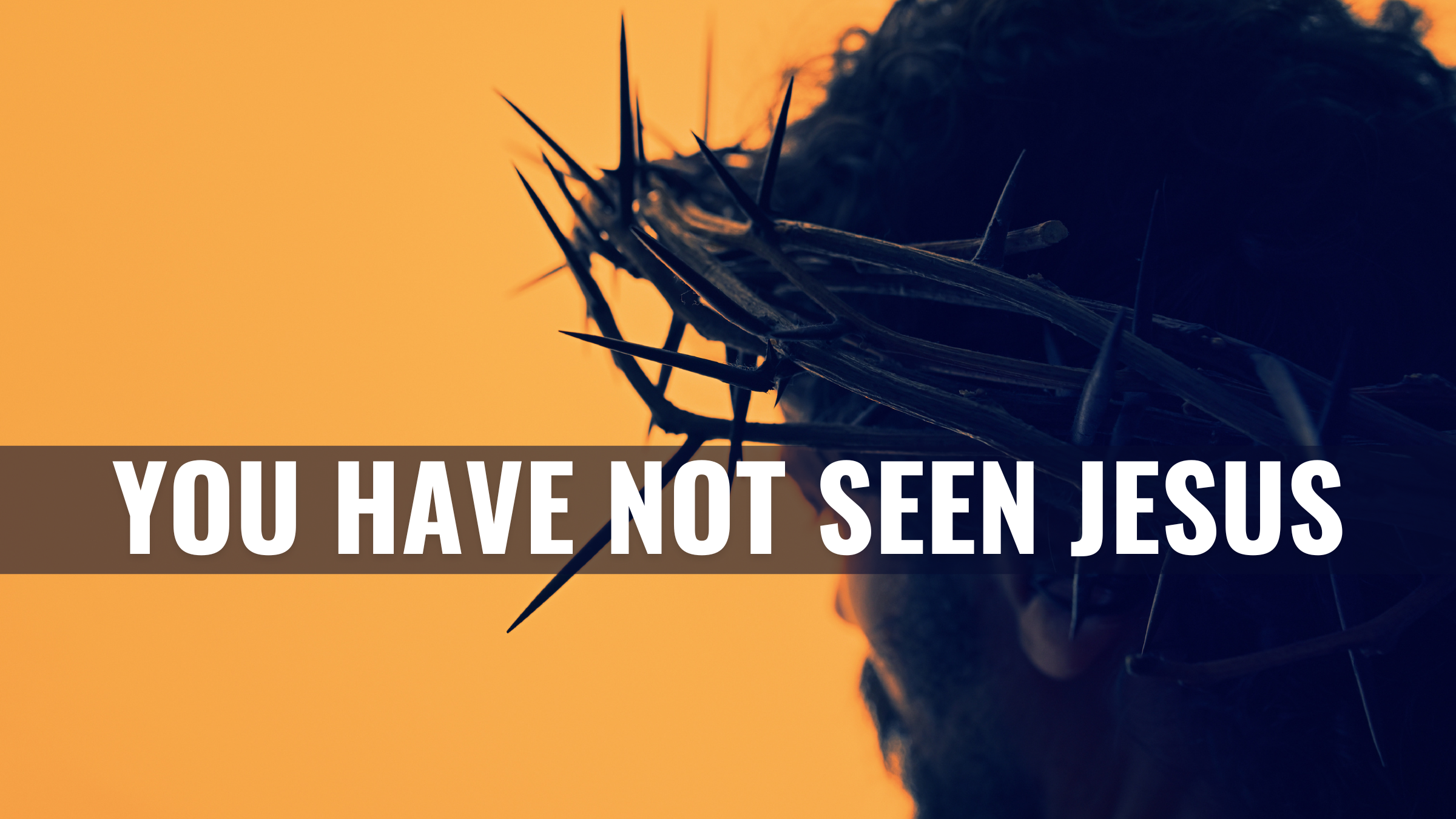You Have Not Seen Jesus
“To whom then will you liken God? Or what likeness will you compare with Him?” — Isaiah 40:18
You’ve never seen Jesus. Not once. Not even close. And if that statement feels confrontational, it should. Because it cuts through centuries of artistic sentiment, religious tradition, and emotional nostalgia to confront a raw, uncomfortable truth: every image you’ve ever seen of Jesus Christ—on a wall, in a Bible, or on a screen—was a fabrication.
It doesn’t matter if it was tenderly placed in your grandmother’s hallway, carved into stained glass in your childhood sanctuary, or animated in a kids’ Sunday School video. Whether it’s a weeping Jesus, a glowing Jesus, or a gently smiling Jesus in a made-for-TV miniseries, every one of them is a lie. None of them are Him. Not one.
And what’s more, this isn’t just a matter of accuracy. This is a matter of obedience. If the God of heaven had wanted us to have a portrait of Christ, He could have made it so. He could have inspired a sketch, ordained a statue, or allowed cameras to exist in first-century Judea. But He didn’t. Not by omission, but by design. Not by accident, but by command.
THE COMMANDMENT WE IGNORE
The Second Commandment is not subtle. It does not merely forbid the worship of false gods; it forbids the very act of making any image that represents God. “You shall not make for yourself an idol, or any likeness of what is in heaven above or on the earth beneath or in the water under the earth” (Exodus 20:4, NASB 1995). The problem isn’t just bowing to the image—it’s building it.
This is why the golden calf incident in Exodus 32 is so haunting. When the people of Israel made the calf, they didn’t say it was Baal. They said, “This is Yahweh, who brought you out of Egypt.” They didn’t reject the true God; they tried to honor Him in a way He had never authorized. They made an image, and in doing so, they brought the wrath of God upon themselves.
That wasn’t an isolated case. In Deuteronomy 4, as the next generation prepared to enter the land, God reminded them: “You saw no form on the day the Lord spoke to you at Horeb… so watch yourselves carefully, lest you act corruptly and make for yourselves a carved image” (vv. 15–16). God’s invisibility was not an oversight. It was a safeguard. He was not shortchanging visual learners; He was protecting idolaters from themselves.
God is Spirit (John 4:24). He is infinite (1 Kings 8:27). He is invisible (1 Timothy 6:16). Every attempt to depict Him, no matter how sincere or sentimental, ends in distortion. It is always a reduction. Always a misrepresentation. Always a desecration. And always forbidden.
THE CHRIST YOU CANNOT DRAW
Yes, God became visible in the person of Jesus Christ. The Word became flesh and dwelt among us. But even this profound miracle does not grant us the right to represent Him as we see fit. The incarnation is not an invitation to start painting the divine.
Jesus Himself said, “Blessed are those who have not seen and yet have believed” (John 20:29). Paul tells us, “Faith comes by hearing, and hearing by the Word of Christ” (Romans 10:17). Peter praises the saints, saying, “Though you have not seen Him, you love Him” (1 Peter 1:8). Over and over again, Scripture disconnects genuine faith from sight and binds it to the Word. Not one verse ever urges us to fix our eyes on a physical depiction of Christ. Instead, we are called to hear Him, trust Him, obey Him, and love Him—without ever once seeing Him.
More than that, theologically speaking, portraying Jesus is reckless. He is one Person with two natures: fully divine and fully human. No brush can paint both. To depict only His humanity is to sever His divinity, committing the ancient heresy of Nestorianism. To attempt to capture His divinity on canvas is an affront to the holiness and infinity of God. To try to portray both in one stroke is not art—it is theological malpractice.
Notice how Scripture is intentionally silent on the physical details of Jesus. We don’t know His height, skin tone, hair color, or facial structure. That silence isn’t accidental. It’s inspired. It’s deliberate. God doesn’t want us obsessing over how Jesus looked. He wants us consumed by what He said and did.
As John Calvin rightly thundered, such images are nothing but “an impious falsehood.”
THE WORSHIP GOD DEMANDS
The Reformed tradition, standing firmly on the Word of God, has consistently understood this. The Westminster Larger Catechism states plainly: “The sins forbidden in the second commandment are… the making any representation of God, of all or of any of the three persons, either inwardly in our mind or outwardly in any kind of image or likeness.” The Heidelberg Catechism teaches: “That we in no way make any image of God, nor worship Him in any other way than He has commanded in His Word.” This isn’t a fringe position. This is the historic, biblical conviction of the church that fears God and takes His commandments seriously.
This also touches the heart of the Regulative Principle of Worship. We don’t approach God however we please. We don’t innovate sacred space. We worship only in the way He prescribes. Colossians 2:23 calls man-made religion “will-worship”—a self-generated offering that God never asked for and never accepts. And as theologian Michael Bushell puts it, “Images of Christ are not neutral—they are human creations unauthorized by God, and thus constitute false worship.”
It’s also naïve to think that images of Jesus remain just “images.” They inevitably become objects of devotion. People cry before them. Pray toward them. Form affections around them. That is worship. Unauthorized worship. And therefore rebellion.
But this is not just about external artwork. It’s about the internal images we’ve crafted in our minds and hearts—a sentimental, passive, emasculated Jesus who smiles at sin, coddles rebellion, and never calls anyone to repent. That Jesus doesn’t exist. That Jesus is an idol. Carved not from wood or stone, but from our own rebellion.
If the Jesus you love lets you stay in your sin, the Jesus you love is false. He is a mirror of your preferences, not a revelation of God.
Parents, if you want your children to love Christ, do not give them illustrations, cartoons, or screenplays. Give them His Word. Preach Christ. Sing Christ. Obey Christ. The real Christ is more glorious than anything ever painted. Don’t trade Him for pixels and brushstrokes. Give your children truth—not sentimentality. Give them Scripture—not sketches.
Romans 8:29 says we are predestined to be conformed to the image of Christ, but that image is moral, not physical. It’s His character, not His countenance. His righteousness, not His race. The world fixates on His appearance. The church must fixate on His holiness.
THE GLORY YET TO BE SEEN
Christ is not for our eyes. He is for our ears, our hearts, and our lives. He is not meant to be painted, pixelated, or portrayed. He is meant to be preached, proclaimed, and passionately obeyed.
Let the world make idols. Let Rome venerate its icons. Let apostates fill their sanctuaries with sentimental blasphemies. But let the church of Jesus Christ stand apart. Let us declare with trembling reverence and unyielding resolve:
I will not diminish my Redeemer. I will not insult my King with brushstrokes. I will not dishonor the Word made flesh by reducing Him to a man-made image.
We have something infinitely better than art. We have the Spirit of Christ within us. We have the Word of Christ before us. We have the gospel of Christ to proclaim. We have the table of Christ to nourish us.
And one day, we will see Him. Not as artists imagined. Not as culture distorted. Not as our hearts misled. But as He truly is.
“When He appears, we will be like Him, because we will see Him just as He is” (1 John 3:2).
Until that day, we walk by faith, not by sight.
We worship in spirit and truth.
And we repent of every false image we’ve ever allowed to live in our hearts.


